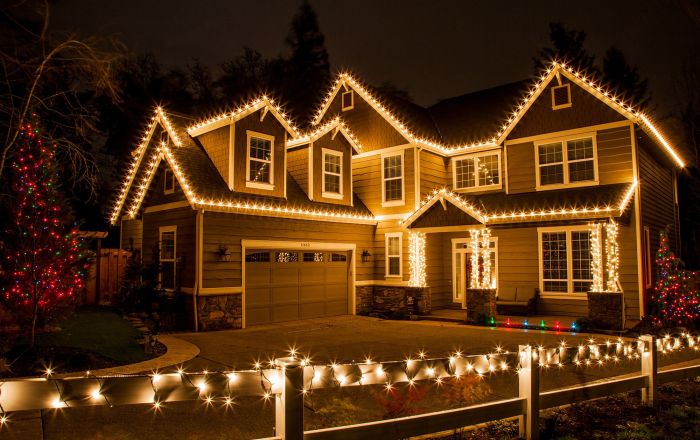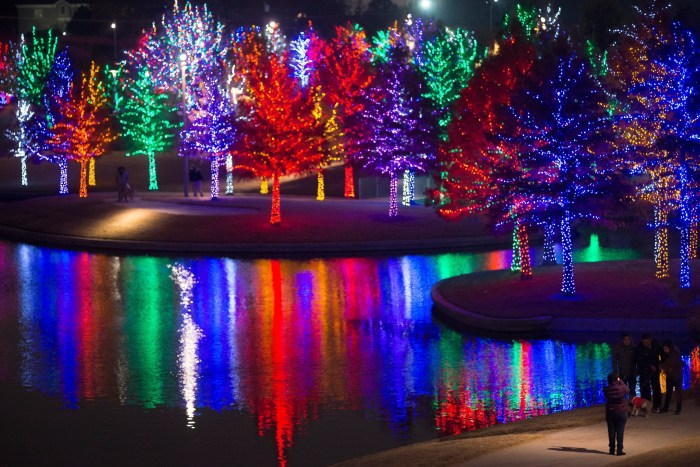Types of Christmas Decor Lights

Christmas decor light up – Choosing the right Christmas lights can significantly impact the overall aesthetic and ambiance of your holiday decorations. Understanding the different types available, their features, and energy efficiency is key to creating a festive and energy-conscious display. This section will explore various options to help you make informed decisions.
Christmas Light Types and Their Characteristics
The following table Artikels several common types of Christmas lights, highlighting their features, benefits, and typical applications.
| Type | Features | Benefits | Applications |
|---|---|---|---|
| Incandescent | Traditional warm glow, relatively inexpensive upfront cost. | Creates a classic, nostalgic look. | Residential homes, traditional displays. |
| LED (Light Emitting Diode) | Energy-efficient, long lifespan, available in various colors and styles (e.g., warm white, cool white, multicolored, twinkling). Often come in strands, nets, or icicle shapes. | Lower energy bills, reduced replacement costs, wide variety of design options. | Residential and commercial applications, both indoor and outdoor. |
| String Lights | Available in incandescent, LED, and other technologies. Varying lengths and bulb spacing. | Versatile for wrapping around trees, railings, or draping across walls. | Indoor and outdoor use, decorating trees, outlining architectural features. |
| Net Lights | Pre-lit mesh or net design, easy to drape over bushes, shrubs, or larger objects. | Quick and easy installation, provides even coverage over large areas. | Covering bushes, trees, and fences for a uniform glow. |
| Projection Lights | Project images or patterns onto walls or surfaces. Usually LED based. | Creates a large-scale festive display with minimal effort. Can project snowflakes, stars, or other holiday designs. | Exterior walls, fences, or other large surfaces. |
Energy Efficiency of Christmas Lights
LED lights are significantly more energy-efficient than incandescent lights. A typical incandescent bulb uses considerably more wattage to produce the same amount of light as an LED. For example, a traditional incandescent Christmas light might use 5-7 watts per bulb, while an LED light might only use 0.5-1 watt. This translates to substantial energy savings, especially when using many lights across a large display.
The longer lifespan of LEDs also contributes to long-term cost savings by reducing the need for frequent replacements.
Aesthetic Differences in Light Colors and Styles
The choice of light color and style dramatically impacts the overall mood and appearance of your Christmas decorations. Warm white lights create a cozy and traditional atmosphere, often preferred for residential settings. Cool white lights offer a brighter, more modern look. Multicolored lights bring a playful and vibrant feel, while icicle lights, usually LED, provide a cascading effect, often used on rooftops or along window frames.
Christmas decor light-up options are abundant this year, ranging from traditional string lights to more elaborate projected displays. For a festive touch on a smaller scale, consider sprucing up your workspace with creative decorations; you might find inspiration for your office door at this helpful resource on christmas office door decor. Ultimately, the best Christmas decor light-up scheme depends on your personal preference and available space, but remember, even small touches can make a big difference.
The choice depends entirely on personal preference and the desired aesthetic.
Popular Christmas Decor Light Display Ideas

Choosing the right Christmas light display can significantly enhance your home’s festive charm. The style of your home’s exterior and your personal aesthetic preferences should guide your selection. Below are several unique ideas to inspire your holiday decorating.
Christmas Light Display Ideas for Different Home Styles
The following examples illustrate how to tailor Christmas light displays to complement various architectural styles. Consider the size, shape, and color palette of your home when selecting your lighting scheme.
- Victorian Home: A Victorian home’s intricate details call for a similarly detailed lighting scheme. Imagine warm white icicle lights cascading from the roofline, outlining the gables and windows. Add strings of warm white mini-lights outlining the porch railings and wrapping around pillars, creating a warm and inviting glow. Consider incorporating larger, ornate star-shaped lights near the peak of the roof for a touch of elegance.
The overall effect should be abundant, creating a magical and slightly whimsical ambiance.
- Modern Home: Modern homes often favor clean lines and minimalist aesthetics. For a modern look, opt for sleek LED strip lights in cool white or a bold color like deep blue or vibrant red. Use these lights to highlight architectural features such as the roofline, window frames, and walkways. Keep the design simple and uncluttered, focusing on geometric patterns and strategic placement for a sophisticated and contemporary feel.
Avoid overcrowding the space with lights.
- Rustic Home: A rustic home’s charm lies in its natural and unpretentious character. Embrace this aesthetic with warm white or amber-colored string lights, strategically placed to highlight the home’s natural textures. Consider using larger, globe-shaped bulbs for a vintage feel. Wrap lights around trees near the house, drape them over fences, and use them to illuminate pathways. The aim is to create a cozy, inviting glow that enhances the home’s natural beauty.
- Traditional Home: A traditional home benefits from a classic Christmas light display. Think evenly spaced strings of warm white mini-lights outlining the roofline, windows, and doors. Add larger, C7 or C9 bulbs in a matching color to highlight architectural details. A balanced and symmetrical design, reflecting the home’s classic style, is key. This approach ensures a timeless and festive look without overwhelming the house’s architecture.
- Contemporary Home: Contemporary homes often blend modern and traditional elements. To create a balanced display, incorporate a mix of lighting styles. Use LED strip lights to highlight architectural details, while adding strings of warm white mini-lights for a softer, more traditional touch. Experiment with different colors, but maintain a cohesive overall aesthetic by sticking to a limited color palette.
This approach allows for both modern sleekness and classic charm.
Installing Icicle Lights on a Roofline
Proper installation of icicle lights is crucial for safety and aesthetics. Always prioritize safety when working at heights.
- Preparation: Inspect your roof for any damage or loose shingles. Ensure you have a sturdy ladder and a helper to assist with installation. Gather all necessary tools, including extension cords, zip ties, and gloves.
- Planning: Plan the placement of your lights to ensure even coverage and avoid overcrowding. Consider the length of your icicle lights and the spacing between strands.
- Installation: Begin at the highest point of your roof and work your way down. Secure the lights with zip ties, ensuring they are firmly attached but not so tight as to damage the lights or your roof. Avoid pulling or stretching the lights excessively.
- Safety Precautions: Always use a sturdy ladder and have a helper hold the base. Never work alone, and avoid working during inclement weather. Wear appropriate safety gear, including gloves and sturdy shoes. Ensure your extension cords are weather-resistant and properly grounded.
- Testing: Before leaving the lights up, thoroughly test all connections to ensure they are functioning correctly.
Creative Indoor Christmas Light Uses, Christmas decor light up
Integrating Christmas lights into your indoor décor adds a touch of warmth and magic.
- Jar Lanterns: Fill mason jars with battery-operated fairy lights for a charming and rustic ambiance. These can be placed on mantels, windowsills, or tables.
- Wreath Illumination: Wrap strings of mini-lights around your Christmas wreath for a warm and inviting glow. Consider using warm white or colored lights to complement your wreath’s design.
- Illuminated Trees: Wrap miniature lights around the branches of your artificial or real Christmas tree for a magical effect. Experiment with different light colors and patterns to achieve your desired look.
- Staircase Lighting: Drape strings of lights along your staircase banister for a festive and welcoming touch. Use warm white lights for a classic feel or colored lights for a more playful look.
- Window Displays: Create captivating window displays by using a combination of string lights, candles, and festive decorations. Consider using battery-operated lights to avoid the need for electrical outlets near your windows.
Safety and Maintenance of Christmas Lights: Christmas Decor Light Up
Christmas lights, while adding festive cheer, present potential safety hazards if not handled correctly. Understanding and implementing proper safety procedures is crucial to prevent accidents and ensure the longevity of your light displays. This section Artikels key safety concerns, proper handling techniques, and a checklist for pre-use inspection.
Potential Safety Hazards Associated with Christmas Lights
Improper use of Christmas lights can lead to several serious risks. The most significant concerns are fire hazards and electrical shocks. Faulty wiring, overloaded circuits, and the use of damaged lights are primary causes of electrical fires. Overheating from improperly insulated wires or lights left on for extended periods can ignite nearby flammable materials like trees or curtains.
Furthermore, damaged insulation can expose live wires, posing a risk of severe electrical shock. Water damage can exacerbate these risks, making wet lights particularly dangerous. For example, a string of lights left outside during a rainstorm could short-circuit and cause a fire, or if someone touches a damaged light with wet hands, they risk an electric shock.
Proper Procedures for Handling and Storing Christmas Lights
Careful handling and proper storage are vital for extending the lifespan of Christmas lights and preventing hazards. Before putting lights away, thoroughly inspect each string for any signs of damage, such as frayed wires, broken bulbs, or exposed connectors. Damaged lights should be discarded immediately. When storing lights, gently coil them around cardboard tubes or use specialized storage containers to prevent kinks and tangles.
Avoid squeezing or crushing the lights, as this can damage the wires and bulbs. Keeping lights dry and in a cool, dark place is essential to prevent deterioration and ensure they remain in good condition for the next holiday season. For instance, storing lights in a sealed plastic bag in a cool basement will protect them from moisture and temperature extremes.
Christmas Light Inspection Checklist
Before decorating, a thorough inspection is crucial. This checklist helps ensure your lights are safe for use.
- Check each bulb for damage or looseness.
- Inspect all wires for cuts, frays, or exposed conductors. Replace any damaged strings immediately.
- Ensure all connectors are firmly secured and free from damage.
- Test each string of lights to confirm they function correctly. If any section doesn’t light, isolate the problem and repair or replace as needed.
- Never use lights with damaged cords or loose connections. Repairing them yourself can be dangerous, so always replace damaged strings.
- Check the wattage of your lights and ensure they don’t exceed the recommended capacity of your electrical outlets or extension cords.
- Never overload an outlet; avoid plugging multiple strings into a single outlet using daisy-chaining or multiple adaptors.
- Avoid using indoor lights outdoors, as they are not designed for exposure to the elements.
